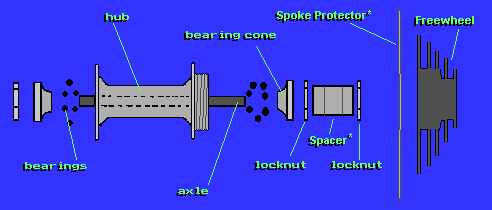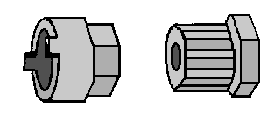"Save Big With Bicycle Discount Coupon Codes"
Bicycle Tune-Up Step 4 - Adjust The Rear Wheel Bearings
Coaster brake and three-speed hubs have bearings just like front wheels, and are adjusted in nearly the same way.
Coaster Brake Wheels
On most coaster brakes, you must make the adjustment on the right hand (sprocket) side.
Three-Speed Wheels
A Sturmey-Archer or Suntour three-speed hub with a little "indicator" chain must be adjusted only on the left (non-sprocket) side of the hub.
If your bike has a Shimano three-speed with the lever on the right side, then it is adjusted only on the right (sprocket) side of the hub.
Derailleur-Equipped and BMX Bicycle Wheels
On derailleur-equipped bikes, you need to take the freewheel off to adjust the cones properly. You'll need a specific freewheel remover tool for your brand of freewheel. There are about six common types. Take your bike to the bicycle store so they can see what you need and sell you the right one. Most freewheel removers are under twelve dollars.
Insert the remover fully. If it is the type with prongs, screw the axle nut or quick release skewer back on loosely to keep the tool from slipping. Grab the remover in a vise or with a large wrench and unscrew it counter-clockwise (like a jar lid). It may be quite tight. If you are using the pronged type remover, after the freewheel is loosened, remove the axle nut or quick release skewer, before you finish unscrewing the freewheel.
Adjust the wheel bearings just like you would do with a front wheel.

Items marked with * may not be present on all bikes. Outer locknut may be combined with spacer.
You can sometimes adjust the bearing cones without removing the freewheel by working on the left side only. However, you run the risk that the right side locknut (under the freewheel) is not tight enough against the right side bearing cone to keep it from suddenly turning and locking up the rear wheel or damaging the hub. You can not guarantee that the right bearing cone is secure when just the outer locknut on the freewheel side is tight, so it really is best to remove the freewheel and do it right.
Putting the freewheel back on is much easier. Just screw it on, but carefully. Don't cross-thread!

Typical freewheel removers
Overhauling
Overhauling rear wheel bearings on most derailleur-equipped bikes is as easy as front wheel bearings, as long as you can remove the freewheel. Overhauling coaster brakes and three-speed hubs is possible, but rather complex. In most, you remove the left bearing cone, then disassemble the hub from the right (sprocket) side. Do not overhaul a coaster brake or three-speed hub unless you are prepared for the possibility that you may not be able to finish the job.
![]()
Freewheels - Overhaul, General Care and Troubleshooting
"Freewheel" is the name of the group of sprockets on rear wheels of derailleur-equipped bikes. Overhauling freewheels is possible but not easy or recommended for beginners. Most bicycle shop professionals do not overhaul freewheels. The alternatives are to soak the entire unit in solvent, let it dry, then soak a small amount of oil into it, or to replace it. However, replacing a freewheel should only be done if you replace the chain at the same time. That's because the freewheel's sprockets and the chain wear together. As the chain stretches, the spacing between the sprocket teeth also increases. If you replace only one or the other, you may end up with a skipping effect in the highest gears (smallest sprockets).
If you have an occasional, non-rhythmic skip on a bike with an old chain and freewheel, it is time to replace them. If the skip happens at regular intervals, the problem is most likely a stiff chain link, dirt on the freewheel sprockets, or a damaged sprocket tooth.
Most freewheels have a left-hand threaded plate screwed onto the outer surface of their core. The plate has two holes. You can place a small punch against one of the holes, and tap on it with a hammer. The plate will unscrew, and the freewheel will then fall apart. There are lots of (usually 78) 1/8" ball bearings inside which will fall out.
After cleaning the freewheel, put grease in the grooves in which the bearing balls run, and stick the balls into the grease to hold them in position while reassembling the freewheel. Leave a gap for one or two balls in each groove. Do not grease the ratcheted surface against which the two (sometimes three) pawls ('clickers') run, but instead coat it with a small amount of oil. In cold weather, grease could impede the movement of the pawls. You will find a few very thin shims stacked on the core of the freewheel. These fragile shims are used to adjust the closeness of the bearings. Be careful in handling them, because if you damage one and have to leave it out, the freewheel will usually be too tight to work properly. After reassembling the freewheel, set a punch against one of the two holes in the top plate, and bang repeatedly, but lightly against it to tighten it fully. This plate is rather brittle, so you'll want to apply the force as numerous small hits rather than clobbering it.
Most freewheels have removable sprockets, but for many brands, replacements are unavailable. Sprockets can be removed with a pair of tools made by attaching bicycle chain to bars. While holding one such sprocket tool on a large sprocket, unscrew the smallest sprocket and then the second smallest. Most freewheel sprockets have regular right-hand threading.
3 Things You Need To KnowBefore You Buy
![]()
![]()
Tell a Friend About BikeWebSite
Please feel free to link your web pages to www.bikewebsite.com.
![]()
Copyright © 1991-2014, bikewebsite.com